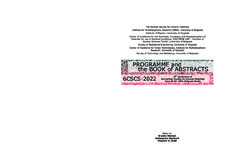| dc.creator | Počuča-Nešić, Milica | |
| dc.creator | Vukašinović, Jelena | |
| dc.creator | Dapčević, Aleksandra | |
| dc.creator | Ribić, Vesna | |
| dc.creator | Branković, Zorica | |
| dc.creator | Vojisavljević, Katarina | |
| dc.creator | Marinković Stanojević, Zorica | |
| dc.creator | Branković, Goran | |
| dc.date.accessioned | 2023-08-03T10:14:54Z | |
| dc.date.available | 2023-08-03T10:14:54Z | |
| dc.date.issued | 2022 | |
| dc.identifier.isbn | 978-86-80109-23-7 | |
| dc.identifier.uri | http://rimsi.imsi.bg.ac.rs/handle/123456789/2031 | |
| dc.description.abstract | Dyes released from textile industries present a big threat to the environment, and
remediation of wastewaters became one of the major scientific challenges. In recent
years, there has been a great need for catalysts that would oxidize pollutants under
dark ambient conditions without the use of external stimulants like light,
temperature, or additional chemicals such as O3, H2O2. Efficient work of these
catalysts would significantly reduce the energy consumption. Among other
materials, perovskite-type oxides with general formula ABO3 emerged as possible
catalysts for dye degradation in the dark conditions. Lanthanum nickelates with
single (LaNiO3) and layered perovskite structure (La4Ni3O10, La3Ni2O7, La2NiO4)
showed good catalytic properties, due to the existence of nickel in two oxidation
states (Ni2+ and Ni3+) and the oxygen non-stoichiometry in these materials [1].
This study presents structural, microstructural and catalytic properties of the
LaNi1-xNbxO3-based (xNb = 0.000, 0,005 and 0,010; La-Ni-Nb-O) powders prepared
by mechanical activation method. The XRD (X-Ray Diffraction) analysis revealed
the existence of a multiphase oxide system, including layered structures of
nickelates Lan+1NinO3n+1 (n = 3, 2, 1, 0) and NiO phase in all La-Ni-Nb-O-based
powders. Also, the HRTEM (High Resolution Transmission Electron Microscopy)
analysis confirmed the presence of structural polytypes in these powders. The
catalytic properties of La-Ni-Nb-O-based powders were investigated by degradation
of the anionic azo dye, Reactive Orange 16 (RO16), under dark ambient conditions
at different pH values (3, 6.5, 9.5 and 11) and temperature of 20 °C. The best
catalytic efficiency in the degradation of RO16 dye showed the sample with x(Nb) =
0.010 in acidic solution, where the residual of RO16 dye was about 4.5 % after 330
minutes. The reusability test for this powder in degradation process of RO16 dye
showed that the sample with x(Nb) = 0.010 retained its catalytic activity during three
cycles.
1. W. Zhong et al., Appl. Catal. A, Gen., 549 (2018) 302. | sr |
| dc.language.iso | en | sr |
| dc.publisher | University of Belgrade, Institute for Multidisciplinary Research | sr |
| dc.relation | Ministry of Education, Science and Technological Development, Republic of Serbia, Grant no. 200053 (University of Belgrade, Institute for Multidisciplinary Research) (RS-200053) | sr |
| dc.rights | openAccess | sr |
| dc.rights.uri | https://creativecommons.org/licenses/by-nc-nd/4.0/ | |
| dc.source | 6th Conference of the Serbian Society for Ceramic Materials, 6CSCS-2022, June 28-29, 2022, Belgrade, Serbia | sr |
| dc.subject | Perovskite-type oxides | sr |
| dc.subject | Lanthanum nickelates | sr |
| dc.subject | Catalytic properties | sr |
| dc.subject | Anionic azo dye | sr |
| dc.subject | Reactive Orange 16 | sr |
| dc.title | The catalytic degradation of RO16 dye under dark ambient conditions using La-Ni-Nb-O-based powders | sr |
| dc.type | conferenceObject | sr |
| dc.rights.license | BY-NC-ND | sr |
| dc.citation.spage | 63 | |
| dc.identifier.fulltext | http://rimsi.imsi.bg.ac.rs/bitstream/id/5355/bitstream_5355.pdf | |
| dc.identifier.rcub | https://hdl.handle.net/21.15107/rcub_rimsi_2031 | |
| dc.type.version | publishedVersion | sr |

